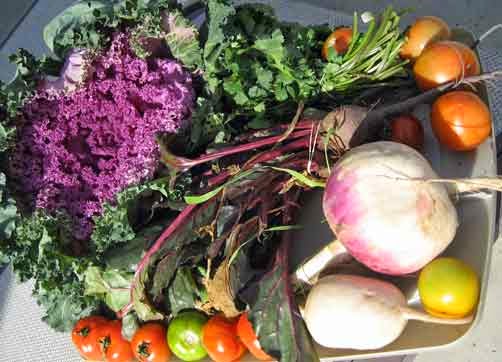Kale, beets, one huge (and one normal size) turnips, tomatoes, cilantro, apples, and green onions (although somehow the apples and green onions didn’t get into the picture). I love getting something new like the kale; the pink - purple leafy thing in thing on the left(although I am becoming dependent on good tomatoes every week). One of my go-to sources on vegetable is Alice Waters Chez Panisse Vegetables
Sautéed Kale with Garlic and Vinegar
1 Bunch of Kale
1 Tablespoon olive oil
Salt
1 clove garlic, smashed and chopped
1-2 teaspoons sherry or red wine vinegar
Cut the tough stems from the kale, coarsely chop, and wash in plenty of water. Drain, but don’t spin dry.
Heat oil in a large sauté pan. Add enough kale to cover the bottom of the pan. Allow the greens to wilt a bit before adding more. When all the kale has been added, season with salt, stir in the garlic, and cover the pan. The greens will take anywhere from just a few minute to 15 minutes to cook (mine took about 10 minutes over relatively low heat), When they are tender, remove the lid and allow any excess water to cook away. Turn off the heat and stir in the vinegar. Serves 2-3 (original recipe was double this).
Other ideas for the week:
Roasted Turnips – peel, cube, toss with a bit of olive oil and roast in a hot (450F) oven. Expect they will take 20 minutes or so depending on cube size, finish with a bit of salt and pepper.
Beets (and cilantro) – I came across a recipe for a beet and carrot salad in one of my favorite food blogs, Zucchini and Chocolate and will try it this week. The beets are used raw… seems like a lot less bother than roasting or steaming. [edit: not recommended!]
Beet and turnip greens – into some soup… either bean or lentil – vegetable.
Tomatoes, cilantro, green onions - sounds like a great start for salsa (luckily I have a chili pepper left from Crooked Sky Farms from last week).
Green onions – have already gone into Pasta Carbonara (translation: pasta with bacon and eggs. Let me know if you want the recipe.)
One of the challenges of getting all your vegetables once a week is to keep everything fresh the week or so until it’s used. I try to do some work when I get home from the farmers market to keep everything fresh and to make it a bit easier to cook later in the week.
Tender greens (lettuce, cilantro, arugula) get a wash and spin dry, then spread on paper towels. I pick out any bruised or otherwise undesirable leaves, then place in a plastic bag (with the paper towels), and into the crisper.
Root vegetables that are dirty get a wash (sometimes outside if really dirty), left on the counter to dry, then into plastic bag and into the fridge. I also remove the tops from things like beets, turnips, and carrots. I wash the greens, spin, and wrap. Here are the beet and turnip greens from this week.
Enjoy!






